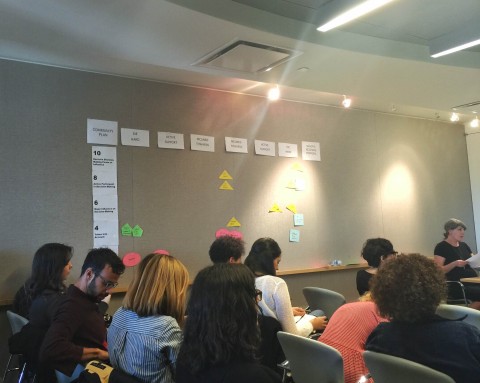Facilitating change and connecting with other grassroots allies is a hurdle for any community-organizing project. There can be gaps in language, culture, and experience as well as a misalignment of goals, as varying backgrounds and skills come together to try to work on a unifying project in often different ways. Partnering for Social Impact was a collaborative, interactive workshop sponsored by the Urban Democracy Lab that sought to aid other organizers in solving the problems that may arise when linking community groups together for a common good.
The Center of Urban Pedagogy (CUP) has developed a meaningful and trusting relationship with a variety of grassroots organizations as a result of mutually engaging, collaborative projects. Christine Gaspar, the executive director at CUP, illustrated how potential partners determined their local needs and approached the CUP instead of a top down, disconnected approach that does not originate in a local way. One audience member expressed her concern for groups that do not have this established trust and questioned Gaspar on how they should approach organizing. Gaspar clarified that trust is something that must take time and “by showing up” and consistently listening to the community’s needs, new organizations can strengthen allegiances and build confidence with their local allies.
One organization that approached CUP was CAAAV, an empowering association that works towards organizing diverse Asian communities often from low socioeconomic areas. CAAAV identified the need to spread awareness about rent regulation laws to address the fact that many tenants were being harassed or coerced into moving out of their regulated apartments. The landlords were exploiting the fact that many residents were not aware of their legal rights. CUP was asked to provide the artists and designers to work with CAAV and its constituents and help create an informative pamphlet on tenants’ rights. By employing a responsible process that included regular presentations to CAAAV’s constituents, the collection and incorporation of feedback, and the collaborative identification of realistic goals, Gaspar’s team was able to produce visually exciting, multilingual materials that shared immediately useful information to rent regulated tenants throughout the city
Language and sensitivity is a barrier that many organizing groups have to tackle before attempting to solve a problem. Alexa Kasdan from the Community Development Project of the Urban Justice Center gave the workshop a helpful acronym to assess whether one’s often privileged voice is needed in conversation: Why Am I Talking (W.A.I.T.). Dylan House of the Hester Street Collaborative also expressed the need for transgressing language barriers when conducting any community work. The Hester Street Collaborative distributed a trilingual survey for determining the design of a new park on the East River waterfront. There were three visioning sessions during which residents were not just asked, “What do you want?” but rather “what realistic goals can be achieved?” With the help of financial analysis, business planning, reviewing contracts, and a culminating town hall meeting, A People’s Plan for the East River Waterfront was produced with input from an impressively large and representative group of Lower East Side residents. Through thoughtful cooperation with the community, the Hester Street Collaborative was able to facilitate new access to this area as well as create a safe space for children and families. While construction is underway, interim parks and artistic programs are employed to engage with the local community.
The Participatory Action Research that Kasdan oversees also echoed this people-centered approach. The program flips the typical academic approach on its head by recruiting community members themselves to conduct research as a way to build power. By identifying people’s problems and centering research on them, Participatory Action Research (PAR) is extremely action-oriented and creates needed legitimacy for community organizations that elevates their platforms and issues.
This research approach was used by Community Action for Safe Apartments (CASA) to organize tenants in the Bronx that were being subjected to illegal fees unrelated to the rent. The research survey targeted one landlord’s tenants and sought to define what the fees were, whether they were being paid, and what their financial impact was. 81% of the tenants experienced these non-rent fees, which could total around $600 dollars in addition to each month’s rent. This community-centered research elevated the issue to the public, increased media attention, and forced the landlord to respond. The citywide “Fees Are Fraud” coalition, which comprises several groups representing tenants experiencing similar illegal charges, was formed after the issue was brought to the public’s attention. This research and alliance created meaningful policy change that enforced the elimination of these non-rent fees and saved city tenants thousands of dollars.
As policies change, multiple stakeholders must come to the table. These stakeholders can be anyone from community organizers to governmental officials. As Mayor Bill de Blasio requires affordable housing to be built through upzoning, a policy that seeks to increase residential density through rezoning, different degrees of power and varying motives interact. Upzoning incentivizes developers to build a certain amount of affordable units when creating residential housing by allowing developers to build higher than the area is zoned for; it is only one part of de Blasio’s larger affordable housing agenda. The “Power Analysis Exercise” is a tool used by Gaspar to map the differing levels of power that groups have and where their values lie. The y-axis had a 1-10 scale of the group’s degree of influence and, using the case study of the Mayor’s rezoning plan, the x-axis measures each group’s commitment to a community plan on one end of the scale or the mayor’s rezoning proposal on the other. Then all groups that have a stake in the zoning plan were placed on the graph, allowing participants to see not only a visual representation of each group’s political position, but also where their power might manifest. This kind of “mind mapping” helps advocacy organizations understand where power may be leveraged and whose buy-in needs to be secured.
As the workshop came to a close, Gaspar, Kasdan, and House reemphasized the need for a focus on people’s needs. As rents skyrocket in New York City and economic divides worsen, community organizing is vital to retaining local power and influence. Partnering for Social Impact successfully assessed the common obstacles of community organizing and gave its attendees concrete ways to solve and avoid those problems.

